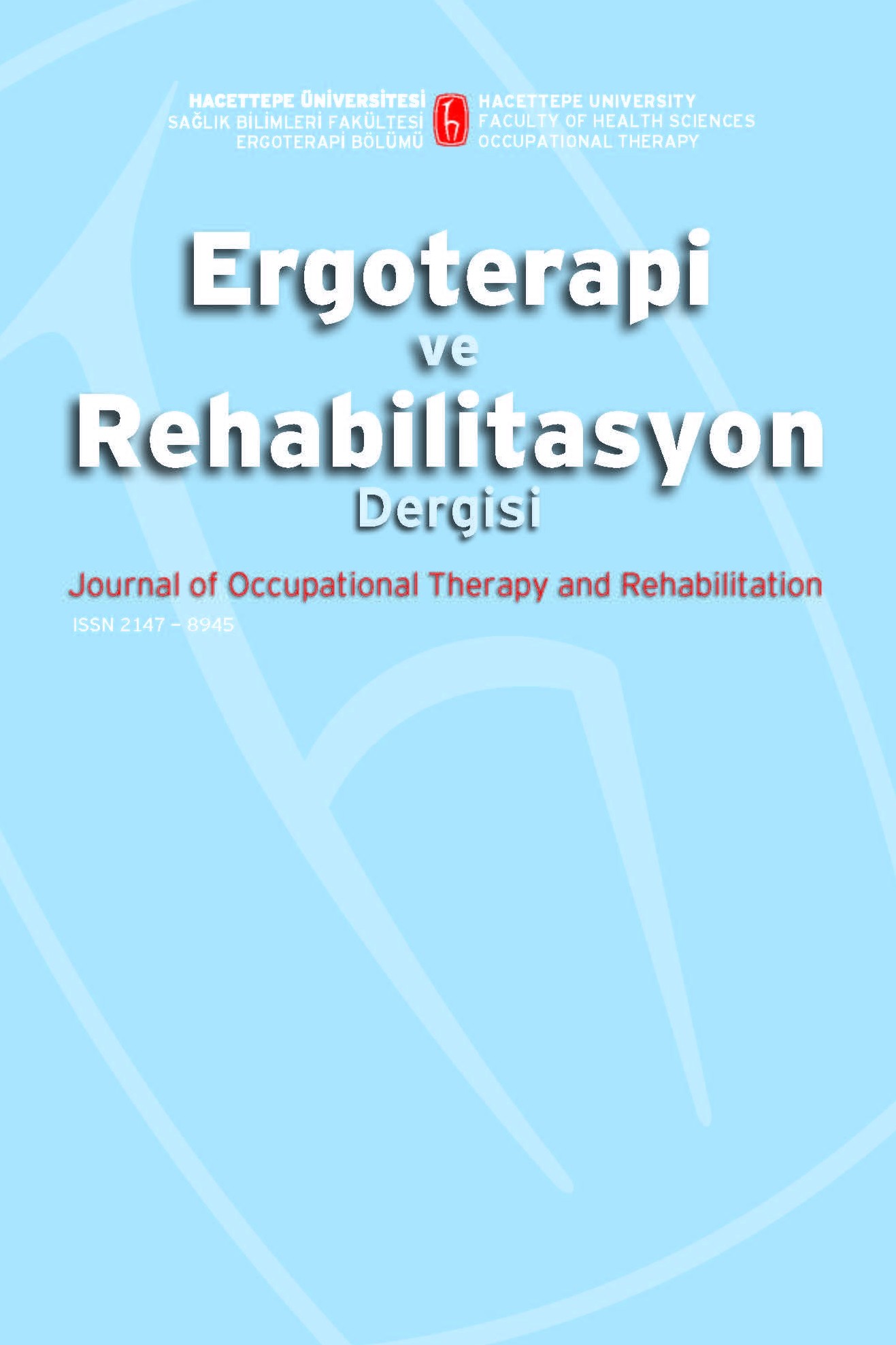Total Kalça ve Diz Artroplastili Hastalarda Kinezyofobinin Erken Dönem Fonksiyonel ve Psikolojik Sonuçlar ile İlişkisi
Amaç: Bu çalışmanın amacı, total kalça ve diz artroplastisi sonrası kinezyofobi seviyesi ile erken fonksiyonel sonuç ve psikolojik stres (anksiyete ve depresyon) arasındaki ilişkinin incelenmesidir. Gereç ve yöntem: Bu kesitsel çalışmaya, total kalça (n=40) ve diz artroplastisi (n=46) olan toplam 86 hasta dahil edildi. Ağrı değerlendirmesi için Görsel Ağrı Ölçütü (GAÖ); fonksiyonel değerlendirmeler için 2 dk yürüme testi (2-DYT) ve süreli kalk yürü testi (SKYT) kullanıldı. Cerrahiden sonra taburculuk gününde tüm hastalara Tampa Kinezyofobi Ölçeği (TKÖ) kullanıldı. Hastane Anksiyete ve Depresyon Skalası (HADS) psikolojik stresin (kaygı ve depresyon) değerlendirilmesinde kullanıldı. Klinik sonuçlarla kinezyofobi arasındaki ilişkiye regresyon analizi ile bakıldı. Sonuçlar: Total kalça ve diz artroplastili hastalar arasında kinezyofobi seviyeleri benzerdi. Ağrı seviyesi (r=0.69, p<0.001), SKYT (r=0.31, p=0.005), ve 2-DYT (r=0.72, p<0.001) kinezyofobi seviyeleri ile ilişkiliydi. Anksiyete seviyesi ve kinezyofobi arasında anlamlı bir ilişki varken (r=-0.58, p<0.001), depresyon seviyesi arasında anlamlı bir ilişki yoktu (p=0.454). Tartışma: Alt ekstremite artroplastisi geçiren hastalarda erken fonksiyonel sonuçlar, ağrı seviyesi ve psikolojik stres cerrahi sonrası ortaya çıkan kinezyofobi ile ilişkilidir
Anahtar Kelimeler:
Artroplasti, Kalça replasmanı, Diz replasmanı, Sonuç değerlendirmesi (sağlık hizmeti)
The Relationship Between Kinesiophobia and Early Functional and Physiological Outcomes in Patients with Total Hip and Knee Arthroplasty
Purpose: The aim of the study is to investigate the relationship between kinesiophobia levels and early function outcomes and psychological distress (anxiety and depression) after total hip and knee arthroplasty. Materials and Method: In this cross-sectional study, 86 patients with total hip (n=40) and knee (n=46) arthroplasty were included in the study. Pain was measured with Visual Analog Scale (VAS), functional outcomes were measured with 2-minute walk test (2-MWT) and the timed up and go test (TUG). The Tampa Scale for Kinesiophobia (TSK) applied to all patients on the day of discharge after surgery. The Hospital Anxiety and Depression Scale (HAD) was used to assess the psychological distress (anxiety and depression). Regression analysis was used to determine the relationship between kinesiophobia and the clinical outcomes. Results: The kinesiophobia levels were similar between total hip and knee arthroplasty patients. Pain levels (r=0.69, p<0.001), TUG (r=0.31, p=0.005), and 2-MWT (r=0.72, p<0.001) were correlated with the kinesiophobia levels. While there was a significant correlation between anxiety level (r=-0.58, p<0.001) and kinesiophobia, there was no correlation between depression level (p=0.454). conclusion: The presence of postoperative kinesiophobia is associated with early functional outcomes, pain levels and psychological distress in patients undergoing lower extremity arthroplasty
- ISSN: 2147-8945
- Yayın Aralığı: Yılda 3 Sayı
- Başlangıç: 2013
- Yayıncı: Hacettepe Üniversitesi Sağlık Bilimleri Fakültesi
Sayıdaki Diğer Makaleler
Gamze EKİCİ, Zeynep ÇORAKÇI, Yasir ŞAFAK
Esra AKI, Keziban TEMUÇİN, Orkun Tahir ARAN
Az Gören ve Görme Engelli Bireylerin Öz Yeterlilikleri ve Baş Etme Becerileri Arasındaki İlişki
Yaşlılarda Aktivite, Çevre ve Yaşam Memnuniyeti İlişkisi
Sinem SALAR, Ayla GÜnAL, Serkan PEKÇETİn, Meral HuRİ, Babak Kashefi MEHR, Gülfer KATIRCIBAŞI, Mine UYANIK
Türkiye’de Erken Müdahale Kavramına Yönelik Yapılmış Lisansüstü Tezlerin İncelenmesi
Hande GÜNEY, Gizem İrem KINIKLI, Sevilay KARAHAN, Onur ÇAĞLAR, Bülent ATİLLA, İnci YÜKSEL
